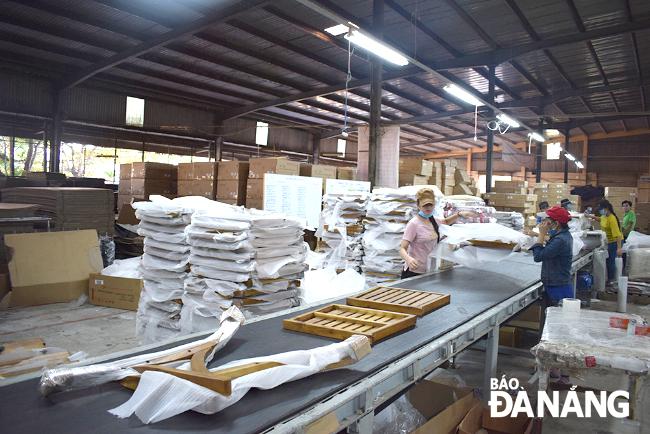Da Nang businesses face opportunities and challenges from EVFTA
Many businesses across Da Nang are focussing on driving innovation and development in addition to seeking new sources of raw materials in a bid to meet the very strict requirements of the EU–Viet Nam Free Trade Agreement (EVFTA) to make good use of the advantages this agreement brings up.
 |
| If used well, the EVFTA agreement will bring great opportunities for local exporters. Workers are pictured working at the Da Nang-based Vinafor Joint Stock Company, which boasts many years of experience in the production and export of wood products. |
Fully aware of the highly beneficial EVFTA, such well-renowned seafood manufacturers, processors and exporters citywide as the Thuan Phuoc Seafood and Trading Corporation and the SEADANANG have rolled out their own long-term plans to make better penetration into the challenging EU market.
Thuan Phuoc, over recent years, has always accounted for a significant proportion of total Da Nang seafood export revenue. The company's products have claimed their berths in many European countries.
SEADANANG General Director Tran Nhu Thien My said SEADANANG is making all necessary preparations to export its products to some EVFTA member countries as early as 2021.
Till date, the Viet Nam Chamber of Commerce and Industry has introduced an EVFTA handbook for domestic businesses, which highlights the most important rules and preparations of the trade deal that Vietnamese firms must study before attempting to conduct business in the EU.
The Quang Nam Province-based Duy Trung garment factory, which belongs to the Da Nang-located 29-3 Textiles and Garments Joint Stock Company, has received a LOTUS BIO V1.1 certification granted by the Viet Nam Green Building Council for meeting the green building criteria.
This demonstrated the company’s efforts in the implementation of the sustainable development goals in addition to protecting the environment - one of the most important requirements set by the European market.
According to domestic economists, the EVFTA is a new generation FTA with the strongest commitments for the EU and Viet Nam on opening their markets, reforms of administrative procedures, institutions and policies.
Seven years after the EVFTA takes effect, the EU will remove 99.2% of import taxes, or 99.7% of export turnover from Viet Nam to the EU. The remaining products will enjoy zero tax. It means that nearly 100% of Vietnamese goods exported to the EU will see import taxes abolished after a roadmap of seven years.
The EVFTA has been expected to increase Viet Nam’s exports by 2.18 to 3.25% in the 2019 - 2023 period and 4.75 to 5.3 in the 2024 - 2033 period.
However, Chairman of the Board of Directors of the company Huynh Van Chinh pointed put to the fact that a shortage of raw materials remained an obstacle that needed to be under the EVFTA’s commitments, besides meeting strict quality criteria, to enjoy preferential tariffs, businesses must implement strict origin requirements.
Specifically, the EVFTA requires rules of origin to apply from fabric onwards, meaning that exports to the EU must use fabric produced in Viet Nam or the EU. The agreement also allows firms to use fabric from countries which have FTAs with both Viet Nam and the EU.
This issue is still a weakness for Viet Nam’s textiles and garments industry because most raw materials are imported from countries that have not signed FTAs with the EU.
The Da Nang government has already mapped out a plan to implement the EVFTA in the city from now until 2025. Focus will be on widely publicising the great benefits of the EVFTA, facilitating local enterprises to gain a deeper insight into the business environments of EU countries and their trade and investment trends during and after the Covid-19 pandemic.
Besides, importance will also be attached to organising in-depth talks between economic experts and businesses, addressing any problems relating to administrative procedures arising during the implementation of the EVFTA, and implementing synchronously and effectively more programmes to help enhance businesses’ competitiveness.
At the same time, how to boost bilateral cooperation between Da Nang and localities in EU countries must be taken into account.
By KHANH HOA – Translated by A.T